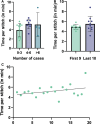Technical Strategies and Learning Curve in Robotic-assisted Peripheral Nerve Surgery
- PMID: 39386097
- PMCID: PMC11463204
- DOI: 10.1097/GOX.0000000000006221
Technical Strategies and Learning Curve in Robotic-assisted Peripheral Nerve Surgery
Abstract
Background: Robotic-assisted peripheral nerve surgery (RASPN) has emerged as a promising advancement in microsurgery, offering enhanced precision and tremor reduction for nerve coaptations. This study investigated the largest published patient collective in RASPN and provided specific technical aspects, operative setups, and a learning curve.
Methods: Data collection involved creating a prospective database that recorded surgical details such as surgery type, duration, nerve coaptation time, and number of stitches. The experienced surgeon first underwent a 12-hour training program utilizing the Symani robot system in combination with optical magnification tools before using the system clinically.
Results: The study included 19 patients who underwent robot-assisted peripheral nerve reconstruction. The cohort included six men (31.6%) and 13 women (68.4%), with an average age of 53.8 ± 18.4 years. The procedures included nerve transfers, targeted muscle reinnervation, neurotized free flaps, and autologous nerve grafts. Learning curve analysis revealed no significant reduction in time per stitch over the initial nine coaptations (4.9 ± 0.5 min) compared with the last 10 coaptations (5.5 ± 1.5 min).
Conclusions: The learning curve for RASPN was compared with early experiences with other surgical robots, emphasizing the importance of surgical proficiency and assistant training. Obstacles such as instrument grip strength and blood clot formation were highlighted, and suggestions for future advancements were proposed. RASPN presents an exciting opportunity to enhance precision; however, ongoing research and optimization are necessary to fully harness its benefits.
Copyright © 2024 The Authors. Published by Wolters Kluwer Health, Inc. on behalf of The American Society of Plastic Surgeons.
Conflict of interest statement
The authors have no financial interest to declare in relation to the content of this article. Disclosure statements are at the end of this article, following the correspondence information.
Figures




References
LinkOut - more resources
Full Text Sources
